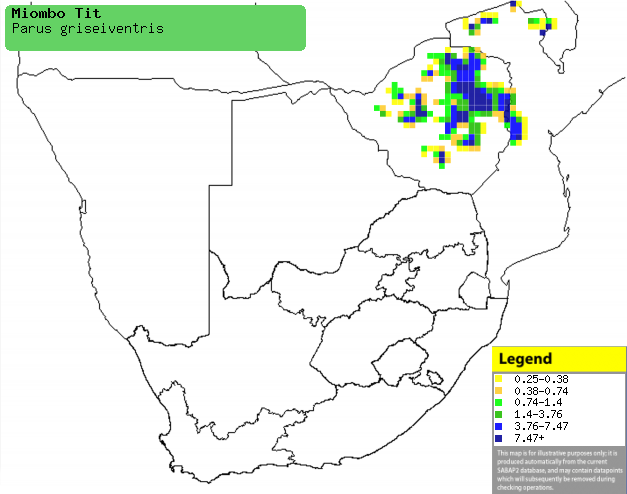|
Parus griseiventris (Miombo tit,
Northern grey tit)
Miombogrysmees [Afrikaans]; Miombo-mees [Dutch]; Mésange
à ventre gris [French]; Miombomeise [German]; Chapim-do-miombo [Portuguese]
Life
> Eukaryotes >
Opisthokonta
> Metazoa (animals) >
Bilateria >
Deuterostomia > Chordata >
Craniata > Vertebrata (vertebrates) > Gnathostomata (jawed
vertebrates) > Teleostomi (teleost fish) > Osteichthyes (bony fish) > Class:
Sarcopterygii (lobe-finned
fish) > Stegocephalia (terrestrial
vertebrates) > Tetrapoda
(four-legged vertebrates) > Reptiliomorpha > Amniota >
Reptilia (reptiles) >
Romeriida > Diapsida > Archosauromorpha > Archosauria >
Dinosauria
(dinosaurs) > Saurischia > Theropoda (bipedal predatory dinosaurs) >
Coelurosauria > Maniraptora > Aves
(birds) >
Order: Passeriformes > Family: Paridae
Distribution and habitat
Endemic to central Africa from Tanzania and southern DRC to
Zambia, with isolated populations in Angola and Zimbabwe. Here it is locally
common in well-developed miombo (Brachystegia), more rarely in other
broad-leaved woodlands such as Baikiaea plurijuga (Zambezi teak).
|
 |
|
Distribution of Miombo tit in southern Africa,
based on statistical smoothing of the records from first SA Bird Atlas
Project (©
Animal Demography unit, University of
Cape Town; smoothing by Birgit Erni and Francesca Little). Colours range
from dark blue (most common) through to yellow (least common). |
Food
It eats mainly eats insects, especially spiders, caterpillars
and other insect larvae. It catches most of its prey from crevices in bark or
patches of lichen. It sometimes joins mixed-species foraging flocks along with
the Ashy tit.
Breeding
- Its breeding habits are little known, but it is probably a facultative
cooperative breeder (i.e. the breeding pair might be assisted by helpers).
- The nest is a thick pad built of animal hair and fine plant fibres,
usually placed in either a natural tree cavity or an old barbet or
woodpecker nest. It also has occasionally been recorded to place it in a
steel fence post or termite mound.
- It lays 3-5 eggs during August-December, with egg-laying activity
peaking in September.
Threats
Not threatened, although the fragmentation of miombo (Brachystegia)
woodland in Zimbabwe is definitely cause for concern.
References
-
Hockey PAR, Dean WRJ and Ryan PG 2005. Roberts - Birds of
southern Africa, VIIth ed. The Trustees of the John Voelcker Bird Book
Fund, Cape Town.
|
